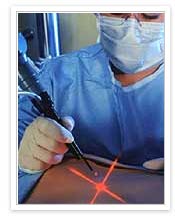|
Components of surgical scalpels
Scalpels have two components -handles and blades used to incise or excise soft tissues, and come in various sizes and shapes. The use of each type depends upon the type and accessibility of the tissue to be cut.
Surgical Scalpel Blades
The blades on scalpels are extremely sharp, merely touching a medical scalpel with bare hands to test it, will cut through the skin. Medical scalpel blades are gradually curved and angled for greater precision when cutting through tissue. They are made of specialized material like obsidian, medical grade fine steel or diamond knife blade. They are appropriately notched to fit into the scalpel handles. Diamond knife blades are the highest precision blades. These blades are extremely sharp, requiring minimum pressure for precision cutting. Obsidian is a more economical version of the same but the material is comparatively more fragile. Carbon steel is now quite common in practice.
Surgical Scalpel Handles
Stainless Steel knife handle are easily gripped, are light in weight, adaptable and can be autoclaved. The surgical scalpel handles are shaped as per the incision to be made. Flat handles or rounded ones can be used for all types of incisions. The round scalpel handles are preferred for rounded or curved cuts. Apart from straight and rounded scalpel handles, an array of their combinations have been created for specialized cuts and maneuvers. Each combination is given a different name like beaver handle, Castroviejo blade breaker, and the Siegel handle. The blades are generally presterilized and disposable. They should be discarded after one use. The blade material may be obsidian (a volcanic glass) or conventional steel or diamond knife. The blades should be attached or removed using hemostatic forceps or scalpel blade removers.
Types of surgical scalpels
- Reusable scalpels: Re-usable scalpels come with attached, re sharpenable blades or with non-attached, replaceable blades. The blades should be attached or removed using hemostatic forceps or scalpel blade removers. The handles can be sterllized and used again.
- Disposable scalpels: These are single use scalpels. Disposable scalpels usually come with a plastic or metal handle with an extensible blade, like for instance, a utility knife and are used once. The scalpel or the blade is discarded after one use.
|
Scalpel Blade Removers
Scalpel blades need to be removed cautiously to avoid damage to the blade, avoid cuts and infections. This can be done using blade removers. The Scalpel Blade Removers are sturdy stainless steel instruments and ensure safety. Though they are of different types the basic procedure remains the same. The blade part is inserted in the remover and sideways pressure exerted to detach the blade from the handle. A simple and effective way to avoid cuts during removal.
Protective sheath in disposable surgical scalpels
A protective sheath for a disposable surgical scalpel consists of least three modes of operation :
- A protective mode: In the protective mode, the locking strip of the scalpel resides in a second opening of the sheath which keeps the sheath immobile when the scalpel blade is not in use.
- An open mode: In this mode, the locking strip of the scalpel handle is found in one opening of the sheath to keep the sheath immobile during use of the scalpel blade.
- A permanently locked mode: In this mode, a button which is connected to the sheath is depressed into the second opening and engages the locking strip, which in turn prevents the blade from being used and allows the scalpel to be safely disposed.
|
|




